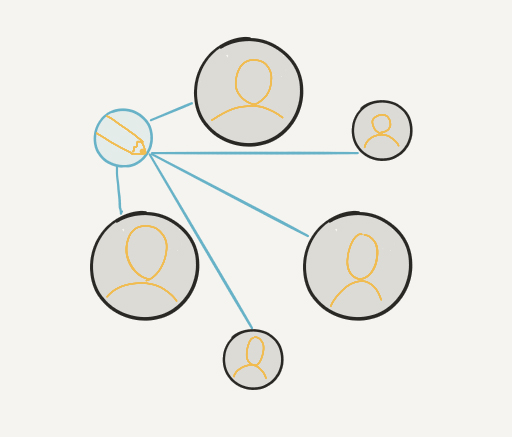As designers, we work in ideas. But we also must work with people. If I could distill everything that I’ve learned as a designer down to one thing it would be this: Ideas are excellent; people are essential.
People are not only vessels for ideas, they bring them into form. As designers we may think we are responsible for both discovering ideas and executing them, but at some point our ideas must live beyond us. They are shared with co-creators, with clients, with stakeholders, with audiences we may never meet.

Unfortunately, as designers we are often not trained or well practiced in this business of inviting others into our process and ultimately letting go of our work so it can serve them. Worse still, our clients may also have expectations and misunderstandings about how much of the work is ours and how much is theirs, and legal contracts alone don’t guarantee clarity.
The way I see it, marketing is becoming more about information and relationships (and less about fabrication and power). We are no longer pushing concepts to clients who push them to passive consumers. This means our jobs as designers are changing, but we are not the only ones who may find this change unnerving.
The good news is that we have much to contribute in the face of ambiguity. After all, we are accustomed to the blank page, to the one-hundredth draft. Designers offer clients much more than thoughtful, innovative concepts and well-crafted products. We can even offer more than a useful way of thinking. We can offer a way of collaborating.
By using design principles, we can make sense of our relationships. We already have the tools for sharing perspectives strategically. Here are some suggestions for how we might use them.
Proportion. Just like all parts of a design must be appropriately sized, so must we understand that as collaborators we are an equal part of a larger whole. We are not all-knowing and neither are our clients all-powerful. We can tell when the head of a figure looks too big for its body, so we must learn to discern when a certain conversation, conflict, or client is less important than we might believe it to be, or more so. There will always be things we cannot change, such as how a client chooses to provide feedback on our designs, but we can always decide to change how we respond.
Balance. What is the weight we are carrying? Are we taking too much responsibility, or too little? Collaborations are all about reciprocity, so sometimes we need to show up and serve and sometimes we need to ask and receive. Know your constraints and communicate them; Nothing is fast, good, and cheap.
Emphasis. We know how to grab a viewer’s attention, and hopefully we also know how to focus our own. What are our highest values and priorities? Do we care more about the type of work we are doing or the type of client? Do we put our current clients first or reaching prospective ones? When we lose focus, we need a north star to re-direct our efforts.
Movement. Like everything, collaborations change. No mistake lasts forever, nor any success. As we’d guide a viewer’s eye, we can also always reframe our own perspective in positive directions. There are always many choices available when we are at a crossroads, and there are always more clients when we diverge from former ones.
Contrast. One day we are excited about a new project, the next we are dreading all the work we know we will have to put into it to have it be what we want it to be. If we pay attention to these highs and lows, we will be more understanding and helpful when our client is going through their own peaks and valleys.
Pattern. Paying attention to our own feelings also allows us to notice habits we might consider changing. We will never be perfect designers, but we can develop a self-awareness that empowers us to be consistent enough to earn the trust of our clients.
Rhythm. Perhaps it sounds like too much work to be creating designs and communicating with collaborators with clarity and ease. Just as we slowly learned about composition and technique, we will make progress with a steady pace.
Unity. It is because of people working together that ideas are possible. But we don’t have to be doormats, or dominators. We can and should consider what’s best for the entire group or project, which may require us to let go of our self-doubt and speak up or to let go of being right and listen.
We should measure our success as designers not merely in terms of the quality designs we create but also in terms of the quality relationships we foster. In my experience, they generally go hand-in-hand.
A good collaboration is both exciting and nerve-wracking. We will be pushed beyond the limits of our own perceived abilities and it will be for the benefit of all.
About Lydia Hooper
Lydia Hooper is a designer and consultant who specializes in communicating about complex topics. She has partnered with more than 30 organizations, offering services and trainings in data storytelling, graphic recording, communications strategy, and visual coaching. Learn and read more blogs at www.fountainvisualcommunications.com.